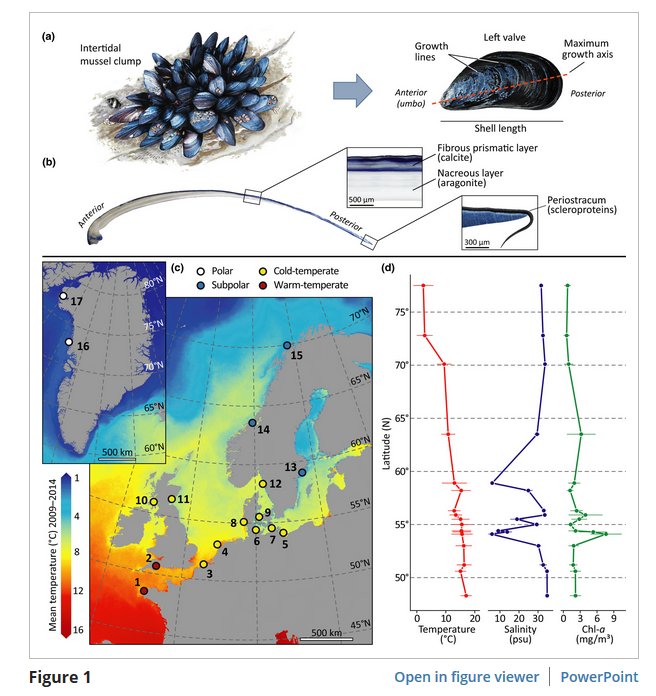Biomineralization plasticity and environmental heterogeneity predict geographical resilience patterns of foundation species to future change
New publication by Luca Telesca, Lloyd S. Peck, Trystan Sanders, Jakob Thyrring, Mikael K. Sejr, Elizabeth M. Harper

Abstract:
Although geographical patterns of species' sensitivity to environmental changes are defined by interacting multiple stressors, little is known about compensatory processes shaping regional differences in organismal vulnerability. Here, we examine large‐scale spatial variations in biomineralization under heterogeneous environmental gradients of temperature, salinity and food availability across a 30° latitudinal range (3,334 km), to test whether plasticity in calcareous shell production and composition, from juveniles to large adults, mediates geographical patterns of resilience to climate change in critical foundation species, the mussels Mytilus edulis and M. trossulus. We find shell calcification decreased towards high latitude, with mussels producing thinner shells with a higher organic content in polar than temperate regions. Salinity was the best predictor of within‐region differences in mussel shell deposition, mineral and organic composition. In polar, subpolar, and Baltic low‐salinity environments, mussels produced thin shells with a thicker external organic layer (periostracum), and an increased proportion of calcite (prismatic layer, as opposed to aragonite) and organic matrix, providing potentially higher resistance against dissolution in more corrosive waters. Conversely, in temperate, higher salinity regimes, thicker, more calcified shells with a higher aragonite (nacreous layer) proportion were deposited, which suggests enhanced protection under increased predation pressure. Interacting effects of salinity and food availability on mussel shell composition predict the deposition of a thicker periostracum and organic‐enriched prismatic layer under forecasted future environmental conditions, suggesting a capacity for increased protection of high‐latitude populations from ocean acidification. These findings support biomineralization plasticity as a potentially advantageous compensatory mechanism conferring Mytilus species a protective capacity for quantitative and qualitative trade‐offs in shell deposition as a response to regional alterations of abiotic and biotic conditions in future environments. Our work illustrates that compensatory mechanisms, driving plastic responses to the spatial structure of multiple stressors, can define geographical patterns of unanticipated species resilience to global environmental change. https://doi.org/10.1111/gcb.14758
